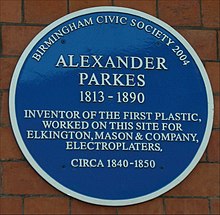Personal and family details
Alexander Parkes was born at Suffolk Street, Birmingham, the fourth son of James Mears Parkes and his wife Kerenhappuch Childs. Samuel Harrison, described by Sir Josiah Mason as the inventor of the split-ring (or key-ring) and widely credited with the invention of the steel pen, was his great-uncle. Parkes was twice married. By his first marriage, to Jane Henshall Moore (1817–50), he had four sons and two daughters (the cricketer Howard Parkes was a grandson), and by his second marriage, to Mary Ann Roderick (1835–1919), four sons and seven daughters. The elder surviving son of his second marriage, Alexander Parkes junior, sometime President of the Association of Certified and Corporate Accountants, presented many original specimens of Parkesine to the Science Museum in 1937, the core of the museum's Parkesine collection.
Parkes' younger brother Henry (1824–1909), a trained chemist, who was married to Fanny Roderick (1837–97), a sister of Alexander's second wife, assisted him in many of his experiments during a collaboration lasting more than fifty years.
It is believed that the Parkes family descends from the Rev. Michael Parkes, Vicar of Penkridge, Staffordshire (died 1617), and had close connections with the metal-working towns of Wednesbury and Wolverhampton in the 16th, 17th and 18th centuries.
